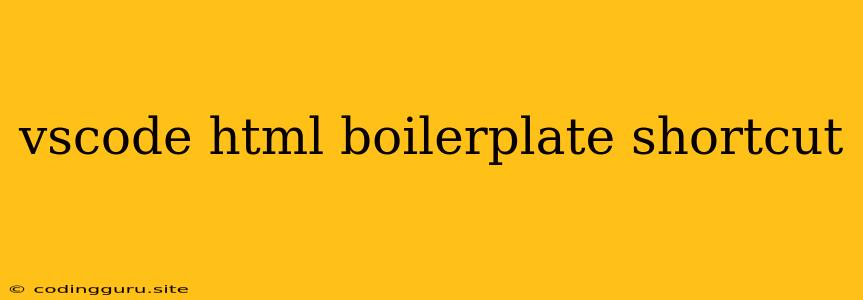VS Code: Automating HTML Boilerplate with Shortcuts
Tired of manually typing out the same HTML boilerplate code every time you start a new project? VS Code offers powerful shortcuts that can significantly streamline this process. Let's dive into how to leverage these shortcuts for efficient web development.
What is an HTML Boilerplate?
An HTML boilerplate is a basic, foundational structure for your HTML document. It usually includes essential elements like:
- DOCTYPE declaration: Specifies the HTML version used.
- HTML tag: Encloses the entire document.
- Head section: Contains metadata like title, links to CSS, and scripts.
- Body section: Holds the visible content of your web page.
VS Code Shortcuts for HTML Boilerplate
VS Code provides a convenient shortcut to generate a standard HTML boilerplate:
1. The "emmet" Extension:
- Install: The
emmetextension is crucial for using these shortcuts. It's typically pre-installed in VS Code, but if not, you can find it in the VS Code extensions marketplace. - Shortcut: Type
!(exclamation mark) and then press Tab. This will generate a complete HTML boilerplate structure.
2. Customized Boilerplates:
- Create a Snippet: VS Code allows you to create custom snippets for your preferred boilerplate structure. This can be particularly useful for projects with unique requirements.
- Access the Snippet: Open the User Snippets section in VS Code (File -> Preferences -> User Snippets or Code -> Preferences -> User Snippets). Choose the language you want (HTML).
- Define your Snippet: Give your snippet a name (e.g.,
my-boilerplate) and paste your custom HTML code. You can also use placeholders ($1, $2, etc.) for dynamic content within your snippet. - Trigger Your Snippet: Type the snippet name followed by Tab (e.g.,
my-boilerplate+ Tab).
3. The html:5 Shortcut:
- Shortcut: Typing
html:5followed by Tab generates a basic HTML5 boilerplate with essential tags.
4. Emmet's Powerful Features:
- HTML Tags: Use abbreviations to quickly generate tags. For example:
div.containergenerates a<div>with the classcontainer. - Nested Elements: Nest elements by using parentheses. For example:
ul>li*3creates an unordered list with 3 list items. - Attributes: Add attributes using square brackets. For example:
img[src="image.jpg"][alt="Image Description"]creates an image element withsrcandaltattributes.
Tips and Best Practices:
- Understand the Boilerplate: While these shortcuts save time, it's crucial to understand the structure of your generated boilerplate. Know what each element does and how they work together.
- Customize as Needed: The generated boilerplate is a starting point. Feel free to modify it with additional elements, CSS, and JavaScript as your project requires.
- Experiment with Emmet: Emmet offers many advanced features and shortcuts that can further speed up your HTML development. Explore the documentation and experiment with different combinations to find what works best for you.
Example: Using Emmet Shortcuts
Let's create a basic HTML page with a heading, paragraph, and an image using Emmet shortcuts:
My Website
Welcome to My Website
This is a sample paragraph.

Code:
html:5
h1>Welcome to My Website
p>This is a sample paragraph.
img[src="image.jpg"][alt="My Website Image"]
Conclusion
VS Code's shortcuts and the emmet extension significantly simplify the process of generating HTML boilerplates. By leveraging these tools, you can reduce tedious typing and focus on crafting compelling web content. Experiment with different shortcuts and explore the capabilities of Emmet to maximize your HTML development efficiency.
